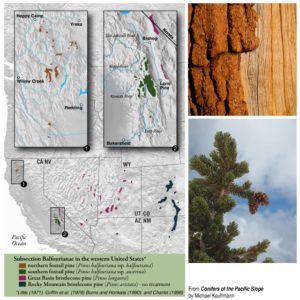Foxtail pine
Pinus balfouriana
Tree: to 100′ and 8′ DBH
Bark: light gray (central Klamath) to reddish-brown (eastern Klamath and Sierra Nevada); becoming ridged, furrowed, and breaking into plates with age
Needles: 1”- 1.5”, 5 per bundle, dense clusters that grow from the branches in circular rings, deep bluish-green (Klamath) to yellowish-green (Sierra)
Seed Cones: 3.5”- 5”, stout, and tapering to a point, without tips on scales, ripening to brown
Habitat: dry, south-facing slopes, 6,600’- 11,500′, generally exposed, in evenly spaced forests, usually with other subalpine conifers, often on serpentine or granite
Observations: (NORTH) northernmost grove at the Lake Mountain Foxtail Pine Botanical Area near Seiad Valley, California is accessible by car, has an active fire lookout at summit; largest pure stand occurs near the summit of Mount Eddy, accessed by a 5-mile hike on the Pacific Crest Trail, dramatic specimens in eastern Trinity Alps Wilderness (SOUTH) groves of trees are not easily accessible; Horseshoe Meadow Road from Lone Pine, California will take you into the Last Chance Meadow Research Natural Area, in the western Sierra Nevada via Mineral King to Timber Gap or Wolverton trailhead with a climb to Alta Peak (all these locations are in Sequoia National Park); Kern and Sirretta peaks in Sequoia N.F.
Remarks: endemic to California’s Klamath Mountains and Sierra Nevada; close relative of Great Basin and Rocky Mountains bristlecone pines
Information from Conifers of the Pacific Slope by Michael Kauffmann.


